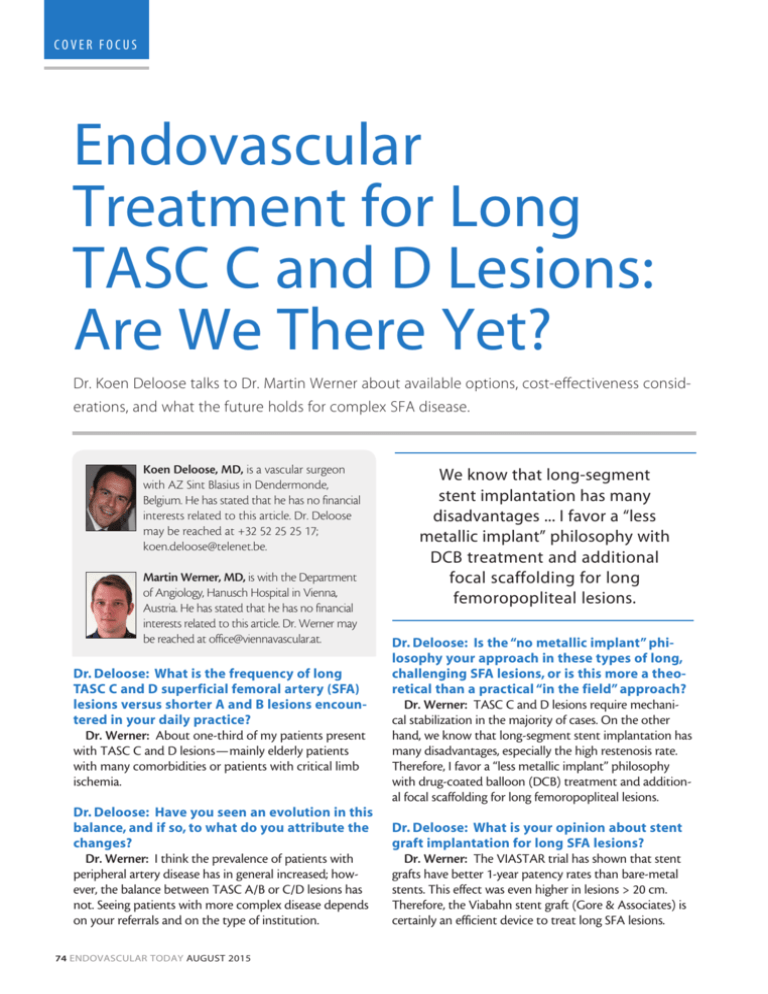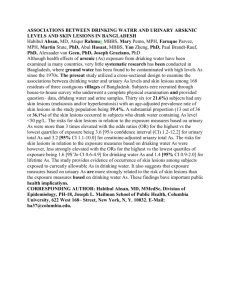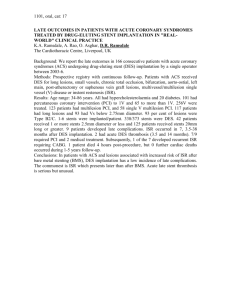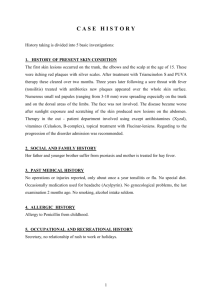Endovascular Treatment for Long TASC C and D Lesions: Are We
advertisement

COVER FOCUS Endovascular Treatment for Long TASC C and D Lesions: Are We There Yet? Dr. Koen Deloose talks to Dr. Martin Werner about available options, cost-effectiveness considerations, and what the future holds for complex SFA disease. oen Deloose, MD, is a vascular surgeon K with AZ Sint Blasius in Dendermonde, Belgium. He has stated that he has no financial interests related to this article. Dr. Deloose may be reached at +32 52 25 25 17; koen.deloose@telenet.be. Martin Werner, MD, is with the Department of Angiology, Hanusch Hospital in Vienna, Austria. He has stated that he has no financial interests related to this article. Dr. Werner may be reached at office@viennavascular.at. Dr. Deloose: What is the frequency of long TASC C and D superficial femoral artery (SFA) lesions versus shorter A and B lesions encountered in your daily practice? Dr. Werner: About one-third of my patients present with TASC C and D lesions—mainly elderly patients with many comorbidities or patients with critical limb ischemia. Dr. Deloose: Have you seen an evolution in this balance, and if so, to what do you attribute the changes? Dr. Werner: I think the prevalence of patients with peripheral artery disease has in general increased; however, the balance between TASC A/B or C/D lesions has not. Seeing patients with more complex disease depends on your referrals and on the type of institution. 74 ENDOVASCULAR TODAY AUGUST 2015 We know that long-segment stent implantation has many disadvantages ... I favor a “less metallic implant” philosophy with DCB treatment and additional focal scaffolding for long femoropopliteal lesions. Dr. Deloose: Is the “no metallic implant” philosophy your approach in these types of long, challenging SFA lesions, or is this more a theoretical than a practical “in the field” approach? Dr. Werner: TASC C and D lesions require mechanical stabilization in the majority of cases. On the other hand, we know that long-segment stent implantation has many disadvantages, especially the high restenosis rate. Therefore, I favor a “less metallic implant” philosophy with drug-coated balloon (DCB) treatment and additional focal scaffolding for long femoropopliteal lesions. Dr. Deloose: What is your opinion about stent graft implantation for long SFA lesions? Dr. Werner: The VIASTAR trial has shown that stent grafts have better 1-year patency rates than bare-metal stents. This effect was even higher in lesions > 20 cm. Therefore, the Viabahn stent graft (Gore & Associates) is certainly an efficient device to treat long SFA lesions. COVER FOCUS Dr. Deloose: What do you think is the ideal indication for drug-eluting stents in long SFA lesions? Dr. Werner: The ZILVER-PTX registry (Cook Medical) has also investigated patients with TASC C and D femoropopliteal lesions and the patency rate was really good. The data, however, were not randomized and therefore are not as robust as for Viabahn. Dr. Deloose: To what degree does cost-effectiveness play a role in your decision making in long SFA lesion treatment, and how do you evaluate the cost-effectiveness of the various available options? Dr. Werner: Reimbursement differs from country to country, and this also explains differences in usage of endovascular devices for complex femoropopliteal lesions. The reduction in reinterventions is a good argument if it comes to discussing higher costs for special devices with the hospital administration. However, level 1 evidence is scarce for many devices and follow-up is often performed for only 1 year, so we do not know if the effectiveness in reducing restenosis and reinterventions for DCBs, for example, also prevails after 5 years. Dr. Deloose: Keeping cost-effectiveness in mind, can debulking first and drug delivery afterwards play a role in long SFA treatment? Dr. Werner: We do not know a lot about the effectiveness of this strategy. Debulking long SFA lesions is not only time-consuming, but also exposes patients and personnel to a higher radiation dosage. The potential for distal embolization is why I always use distal embolic protection devices when using debulking devices. This makes an intervention quite costly, without having any evidence that supports the efforts. Dr. Deloose: What about “coral reef,” calcified, TASC D SFA lesions? Do you still try “endo first” or is this a place for primary surgery? Dr. Werner: In selected cases, endovascular therapy can be supported. However, a vein bypass is the first option if the patient is fit for surgery. In patients with mild symptoms, a conservative approach is also sometimes applied. Dr. Deloose: What are the potential roles and challenges for drug-eluting, resorbable technology in TASC C/D lesions, considering we have mostly seen preliminary short SFA lesion treatment successes to date? Dr. Werner: Bioresorbable scaffold technology is still in its infancy and will not play a role for complex TASC C or 76 ENDOVASCULAR TODAY AUGUST 2015 The reduction in reinterventions is a good argument if it comes to discussing higher costs for special devices with the hospital administration. D lesions within the next few years. However, the mechanical properties of these scaffolds are getting better and the combination of antiproliferative drugs with bioresorbable properties has huge potential. An important challenge is to match the pharmacokinetics of the antiproliferative drug to the process of scaffold resorption. There are some observations supporting the hypothesis that the scaffold absorption process may induce intimal hyperplasia. Therefore, a formula that provides antiproliferative action in the vessel wall for the whole duration of scaffold resorption would presumably provide better results in terms of patency. Dr. Deloose: What does the short-term to intermediate future hold for long SFA lesion treatment? Dr. Werner: Endovascular therapy has already outperformed the results of synthetic femoropopliteal bypass grafts in terms of patency and procedure-related complications. New technologies, including new-generation nitinol stents, drug-eluting stents, stent grafts, and DCBs, are approaching the results of femoropopliteal vein bypass grafts. It is time to perform a randomized study between bypass surgery and endovascular therapy to delineate the best treatment modality for long femoropopliteal lesions. All these new technologies have to be investigated for longer follow-up periods in order to provide meaningful longterm outcome predictions for our patients. Dr. Deloose: Currently, our group in Belgium (five centers) along with five German centers and six Italian centers, runs the ZILVERPASS study, a prospective, randomized, multicenter study to evaluate the performance of the Zilver PTX stent (Cook Medical) compared to bypass surgery for the treatment of TASC C and D femoropopliteal lesions. Primary endpoints are primary patency at 12 months (defined as absence of binary restenosis or occlusion based on color flow duplex ultrasound–measured peak systolic velocity ratio < 2.4, and without clinically driven target lesion revascularization [“endo-based” efficacy endpoint]) and proportion of serious device-related or adverse events within 30 days after the procedure (safety endpoint). At the moment, 95 of 220 patients (43%) have been enrolled. I’m sure we both are looking forward to seeing the results of this first endo-bypass randomization! n






